Preserved Lemons
This post may contain affiliate links. See my disclosure policy.
Get ready to unlock one of the grand secrets of Moroccan and Middle Eastern cuisine by learning how to make preserved lemons in this step-by-step tutorial. These homemade preserved lemons are a powerhouse ingredient that will infuse your dishes with such an incredible flavor and absolutely transform any dish you add them to, whether savory or sweet. Just a few minutes of your time will give you this magical ingredient that keeps for months and you can enjoy all the year through!
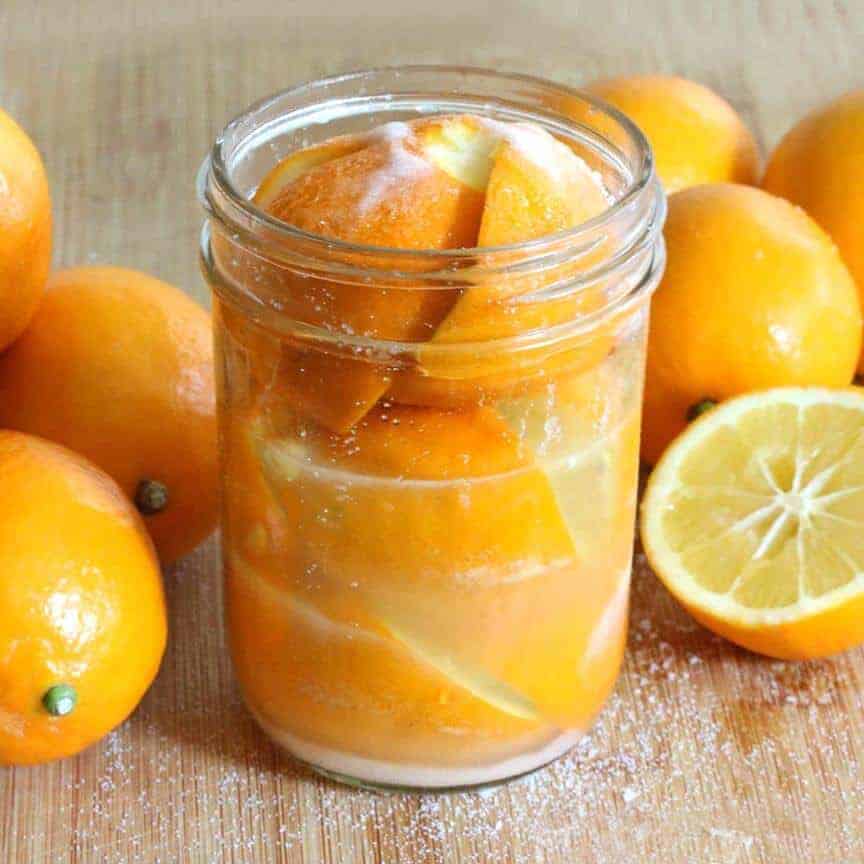
If you’re a fan of Moroccan and Middle Eastern cooking you’ve probably had the experience of thumbing through recipes, drooling all the while, earmarking the ones you particularly like, only to then scan through the ingredients and see the words: “Preserved Lemons”. Your heart sinks for a moment as you realize you are sorely lacking this crucial ingredient. And so with disappointment you un-earmark that page and move on to the next recipe. DON’T let that scenario stop you again. Because nothing could be easier than making your own DIY preserved lemons! These are one of my most favorite “secret” ingredients and I’m going to show you exactly how to make them and how to use them in lots of delicious ways!
What Are Preserved Lemons?
Preserved lemons are lemons that have been packed in salt and their own juices and are left to cure for about a month. During that time the flavors transform in which the acidic tartness disappears and you’re left with a very amplified and complex lemon flavor. Think of preserved lemons as lemons on steroids. They add an intense, concentrated lemon flavor to the dish without all the sour tartness. The preserving process tempers the tartness while accentuating the lemon flavor. In other words, mildly tart but intensely lemony. And if you’re a lover of all things lemon, preserved lemons need a permanent place in your pantry. I can assure you, there is virtually always a jar of these in my fridge!
This preservation process also extends the shelf life of the lemons and they’ll keep for around 6 months in your fridge and even longer if you can them. Over time the lemons become soft and to use them you simply remove however much you need, scrape off the fleshy interior, rinse off the peel, dice it up, and add it to your dishes. Preserved lemons have been around for centuries and are used extensively in Middle Eastern and North African cuisines, most famously Moroccan food. Their unique flavor adds an incredible amount of flavor to a wide variety of savory dishes and desserts.
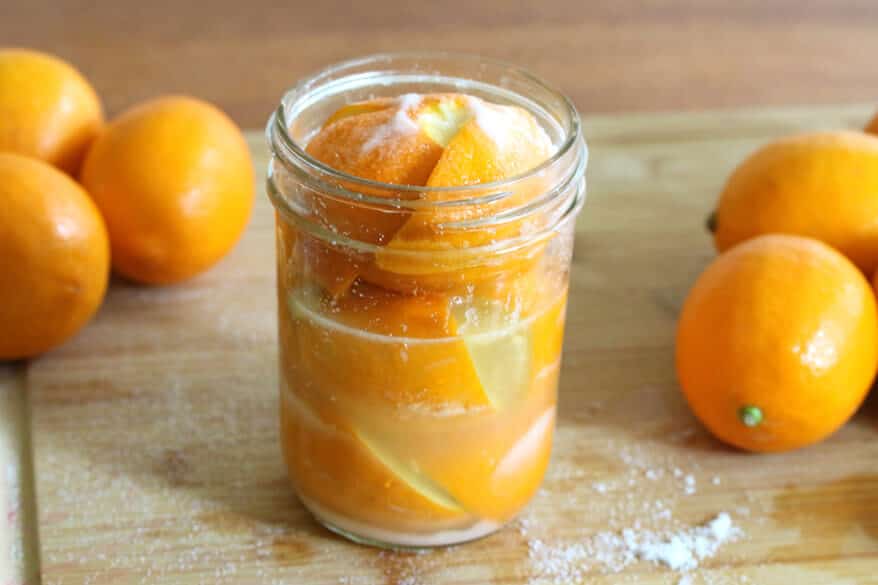
How to Use Preserved Lemons
You’ll find preserved lemons called for in a lot of Middle Eastern and Moroccan recipes, everything from tagines to stews and salads and add a uniquely tangy, salty, and mildly sweet flavor. They can be added to any dish that calls for or can benefit from a touch of lemon flavor. And that includes desserts. Here are just a few ways to use preserved lemons:
- Tagines and stews: a little goes a long way to adding life and flavor. Try them in my Moroccan Harira and Moroccan Chicken Tagine. They’re also great in a variety of bean stews and lentil soups.
- Chicken, duck, beef, lamb, pork, and fish: preserved lemons pair beautifully with any protein. Try them in my Moroccan Chicken (Djej Makalli). And of course lemon and seafood are soulmates. Now just wait until you’ve paired it with preserved lemons and your life is forever changed.
- Salads: Finely mince and toss them into your salads, including pasta salads. They also pair beautifully with grain salads and grain bowls. Try them in two of my personal favorites, this Moroccan Chicken Salad and Curried Couscous Salad.
- Rice, grain, and pasta dishes: try them in my Salmon Risotto – it’s a match made in heaven.
- Marinades: Incorporate them into marinades for chicken, lamb, pork and fish. They add just touch of acidity and a whole depth of flavor.
- Dressings, sauces and dips : Blend them into dressings, vinaigrettes and sauces for an exciting flavor punch. They also work really well in creamy sauces. Add some to your Hummus or Baba Ganoush or to some Greek yogurt along with fresh dill for a refreshing dip.
- Sandwiches and Wraps: you can even add them to your burgers for a fun flavor boost. Oh, and add them to Falafel!
- Salsas and Relishes: chop some up and it to your salsas and relishes for a unique lemony twist like my Mango Salsa and Pineapple Salsa.
- Roasted Vegetables: Toss your roasted veggies with some butter and finely minced preserved lemons for a fabulous flavor. They pair particularly well with root vegetables and cauliflower.
- Cakes, Cupcakes, Muffins, etc: Anything that you would add lemon zest to, try adding some finely minced preserved lemon. Try it in our Preserved Lemon and Ginger Pound Cake.
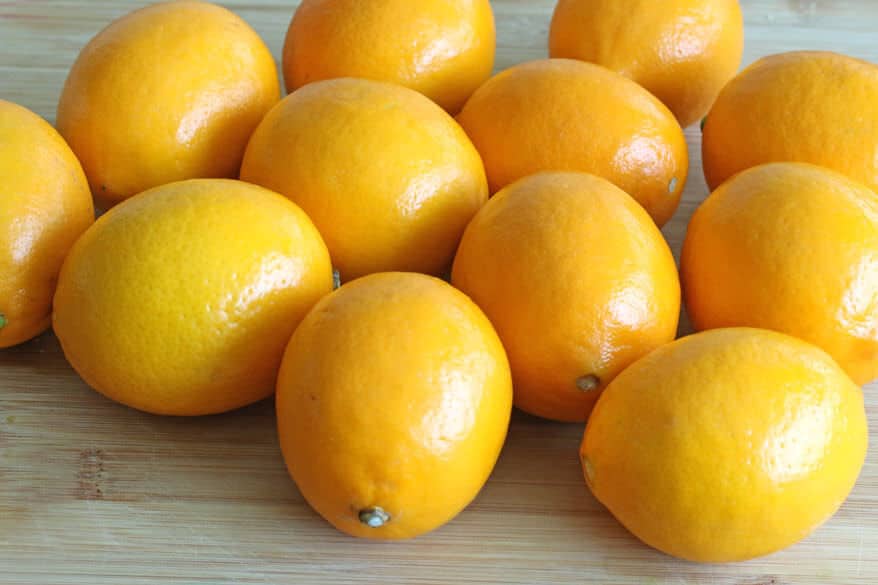
What Kind of Lemons Are Best?
Doqq and boussera lemons are commonly used in Morocco. They have thinner skins and are sweeter than regular lemons. A great substitute is Meyer lemons. If you can’t find Meyer lemons you can use regular lemons such as Eureka or Lisbon. Organic is ideal since it’s the lemon rinds that are eaten.
Variations
Did you know, you can also make preserved limes, oranges, grapefruit and kumquats! The process is identical but because high acidity is required for proper preservation and other citrus varieties have a lower acid content, you will still need to top off the jars with lemon juice. Experiment with these other citrus varieties for some fun flavor variations.
How Long Do Preserved Lemons Last?
Preserved lemons can be stored at room temperature but they’ll ferment very quickly that way and won’t keep as long. It’s recommended to store them in the fridge, in a glass jar with a lid, where they will keep for up to 6 months, and quite possibly longer. Just check periodically for any signs of mold or off colors and smells.
Preserved Lemons Recipe
Let’s get started!
Organic is ideal if you can find them since it’s the rinds that are eaten. If you can’t find organic, let the lemons soak in a vinegar-water solution for a few minutes to clean the outer peels, then rinse.
Trim the nubs off both ends of each lemon.
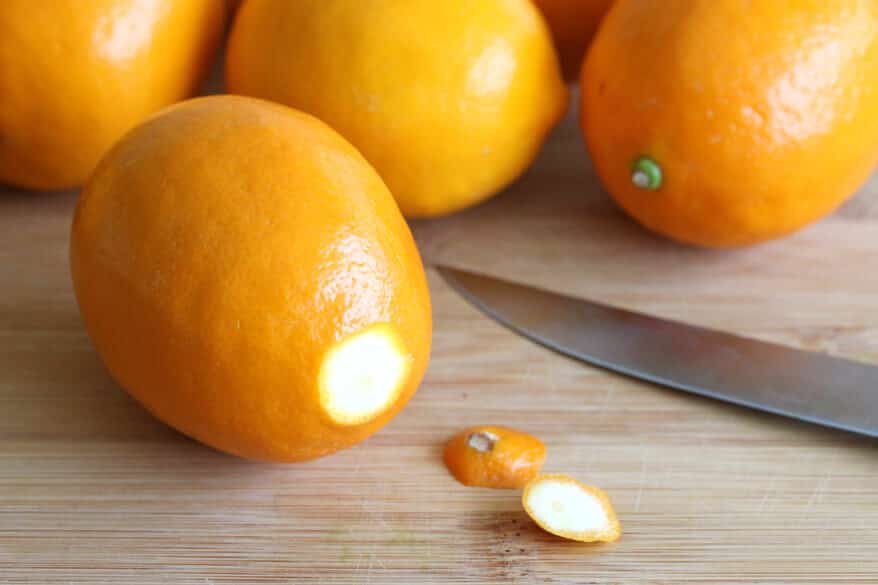
Slice the lemons into quarters, leaving the ends attached. So slice down just a little over 3/4 of the way.
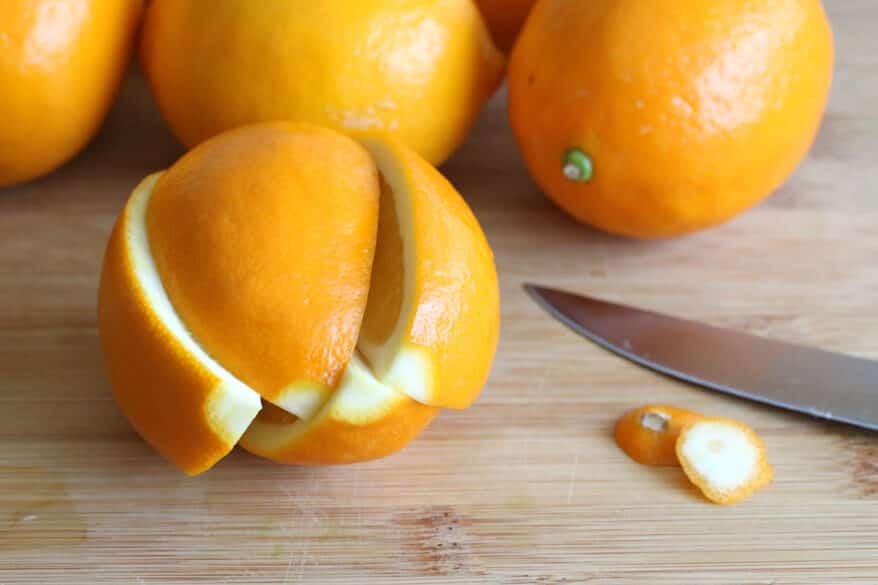
Put a teaspoon of salt in the bottom of a pint-sized jar. Put another teaspoon of salt into the quartered lemon.
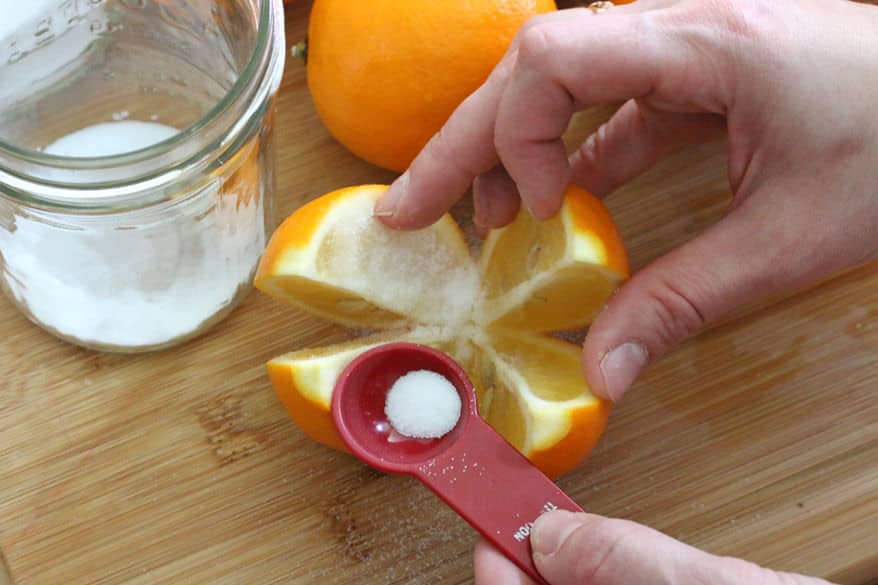
Stuff the lemon into the jar, open end down, and push hard to squish it and release its juices.
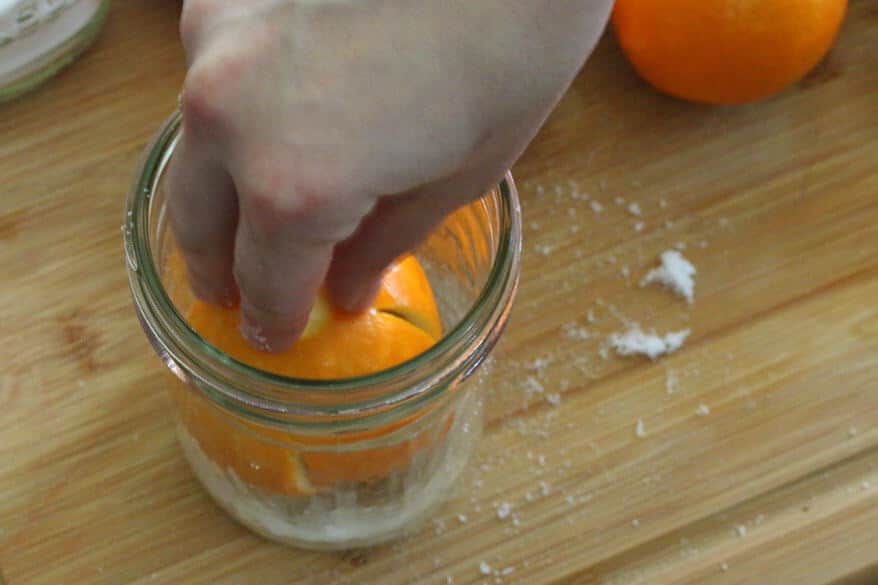
Put a teaspoon of salt over the top of the lemon.
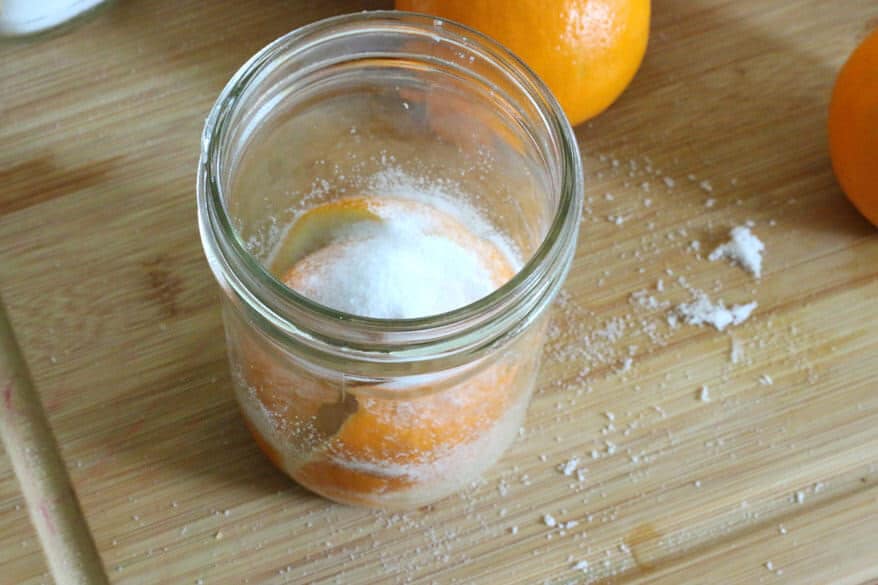
Repeat the process, putting a teaspoon of salt inside the second lemon, and then squish it down hard on top of the first lemon.
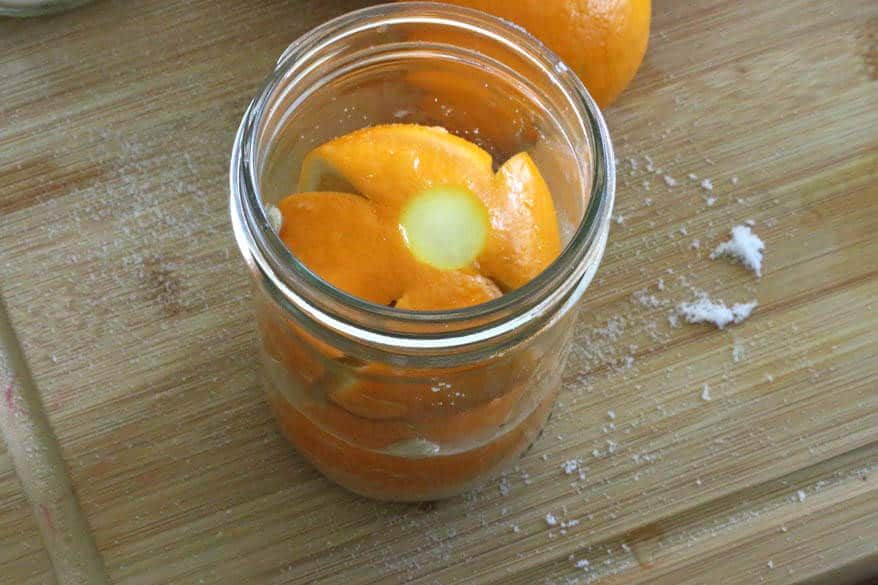
You got it – add another teaspoon of salt on top of the second lemon, and repeat the process for the third and final lemon. Add a teaspoon of salt on the very top. The jar should be at least halfway full of lemon juice from having compressed the lemons. If needed, squeeze some extra lemon juice into the jar to bring it to the halfway point. And don’t waste that lemon – cut it up and stuff it into the jar. Now pour some water that’s been boiled and cooled (sterile) into the jar to fill it up the rest of the way. Repeat this process for however many jars you wish to make.
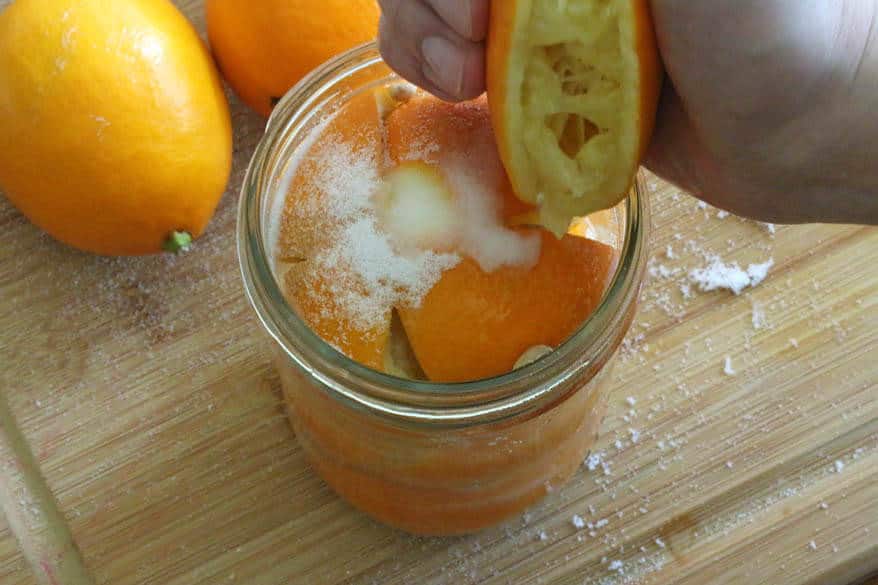
After you add the water, screw on the lid and let the jar sit at room temperature for 3 days, giving it a shake and turn it upside-down/right-side up a few times a day. After 3 days place the jar in the refrigerator and let it sit for at least 3 weeks before using. Keep the jar in the refrigerator. Whatever dish you use them in, discard the pulp (it’s the peel that is used) and thoroughly wash the peel to remove excess salt.
That’s it! Your preserved lemons are ready! *Taste bud choir breaks out into a stirring rendition of the “Hallelujah Chorus”*
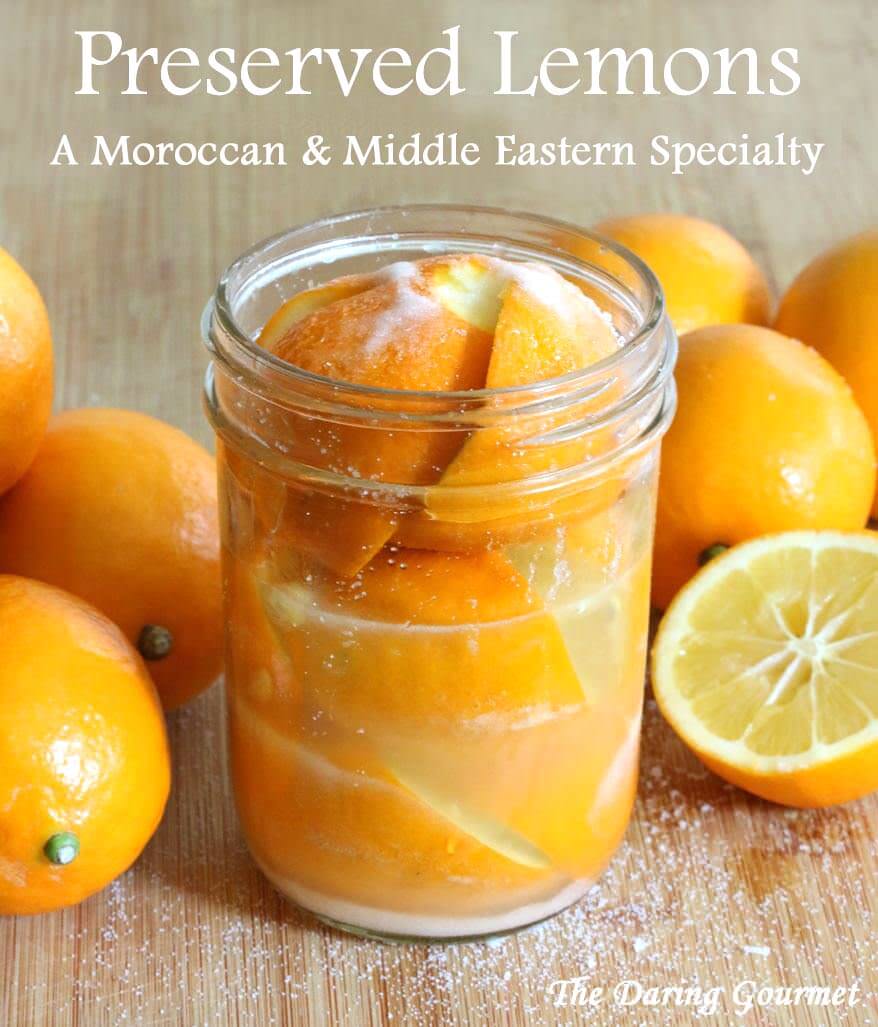
Save This Recipe

Preserved Lemons
Ingredients
- 3 Meyer lemons , or Eureka, Lisbon, etc, organic recommended per pint-sized jar
- 5-6 teaspoons sea salt or kosher salt (regular table salt contains iodine which will turn the lemons gray)
- An extra lemon for juicing
- Water that has been boiled and cooled sterile
Instructions
- Note: you can make however many preserved lemons you like, but roughly 3 will fit per pint-sized jar.Thoroughly clean the lemons. Organic is recommended. If you can't find organic, let the lemons sit in some vinegar water for a few minutes, then rinse.Trim the nubs off both ends of each lemon. Quarter each lemon, slicing them down just over 3/4 of the way to leave the slices attached at the end.Put one teaspoon of salt into the cavity of each lemon.Place one teaspoon salt into the bottom of the jar. Put a lemon in the jar, cut-side down, pressing firmly to squish out the lemon juice. Put a teaspoon of salt on top of the lemon. Firmly press the second lemon down on top of the first lemon. Repeat with the third lemon, pressing down firmly. Add a teaspoon of salt on top of the lemon.The jar should be at least halfway full with lemon juice. If needed, squeeze some additional lemon juice into the jar to bring it to the halfway point. Don't waste that lemon; slice it and stuff the slices into the jar. Pour the boiled/cooled water into the jar to fill it to the top.Screw the lid on and let it sit at room temperature for 3 days, shaking it and rotating the jar upside-down/right-side up a few times per day. After 3 days transfer the jars to the refrigerator and let them sit for at least 3 weeks before using. Stored in the fridge, they will keep for at least 6 months (see note).
Notes
* Whatever dish you use them in, discard the pulp (it’s the peel that is used) and thoroughly wash the peel to remove excess salt. * Using other citrus: You can also make preserved limes, oranges, grapefruit and kumquats! The process is identical but because high acidity is required for proper preservation you will still need to top off the jars with lemon juice.
Nutrition
Originally published on The Daring Gourmet April 8, 2014



















Hi there, is it a must not to use iodised salt?
Thank you lm looking forward to making this recipe.
Nga mihi. Keeti
Hi Keeti, it’s perfectly safe to use it, it will just cause the lemons to become an unpleasant dull, possibly grayish color. It affects the aesthetics more than anything and if you can live with that it’s okay to use iodized salt.
Just doing my first batch.
Questions:
Does the lemon need to be completely submerged?
If so how do I do this?
If needs to be submerged what is better lemon juice or cooled boiled water?
Hi K.S., yes they need to be submerged. If you need additional liquid I recommend using lemon juice or a combination of lemon juice and water (no need to boil it because of the high acidity of the lemons and salt).
Sorry – but the remark that Moroccans are using Meyer lemons is total nonsense.
In fact the Meyer lemon is something rather new – and it is a crossbreed which has been first found in California and probably isn’t found in North Africa at all.
I love to pickle things in my vacuum sealer – and will try to do preserved lemons as well.
And yes – the for sure don’t need to be (for safety reasons at least) refrigerated: salt and acidity (lemon juice) is sufficient, to make it food save. Will it taste good (at least if you are opening it after the “marination time”)? I am not sure – would keep it after opening in the fridge.
What do you mean exactly by removing the flesh and only using the rind? Does this mean to not use any other aspect other than the rind- not the pith and not the internal sections?
Hi Mona, it means you just use the lemon peel. You “can” use the flesh if you like but it’s the peel where the concentrated flavor is and that’s what is typically used when a recipe calls for preserved lemon.
I guess they can be kept in vacuum sealed mason jars for even longer time in the fridge?
Hi Michael, yes I’ve used a hot water bath canner to can them in the past.
How did you waterbath them and what is the expected shelf life?
Hi Marsha, following the same method for canning fruits and jam. Fill the sterilized jars to 3/4 full, screw on the canning lids and rings and boil them in a water bath canner for 5 minutes. Shelf life is about a year. Note: That isn’t an “FDA approved” recipe.
I tried this too, I use this basic recipe all the time. I though substitute the water for more lemon juice as my better half uses up all the juice first. I also make a couple of smaller jars and once they have fermented, I pulse them into a paste which is great for rubbing into chicken, adding into guacamole, rubbing onto steaks with black ground pepper, ok stopping now, Great recipe. thanks
I had some lemons from the “more reputable store” which took to moulding within a day. List three of them to the compost dragon on the balcony. So I thought I’d try my hand at preserved lemons. So the rest went into a quart jar and salted and squeezed and watered. It will be neat to see what comes forth! If it’s a fail the hungry microns on the balcony will be treated to a healthy snack!
I just made my first batch of 6 pints and am anxiously awaiting.
To anyone that is familiar with preserved lemons, do you have a favorite use for the lemon brine after using the rinds? It seems like a waste to pour out afterwards.
Thank you for the recipe. It is easy to follow, clear and concise. I just picked over 100 Meyer lemons from my little tree and made may first jar of preserved lemons. I’m really excited about it. Im looking for other ideas to do with the remainder, eg juice and put in freezer trays etc. However, I might be able to make some preserved lemons for friends.
Hi Kimberley
My preserved lemons have a few mold spots on the top. They have been fermenting for a few weeks in my pantry. Can I remove the top layer where this spotting is, or do I have to throw the lot out?
Hi Angelean, that’s a tough call. What I will say is that in the sauerkraut making process and with fermentation in general, many people feel comfortable scraping off any mold on the top and then continuing on, but that is a call that is ultimately left up to your personal judgment. Whatever you decide to do, be sure to check on your lemons from time to time to ensure they are submerged under liquid as that will prevent mold.
How tight should I close the lid? Will it produce gas and explode? Should I sometimes let the air out? During the 3 day phase in room temperature I mean.
Hi nurp, you can safely close the lid securely but go ahead and let some of the air out after the first few days. In any case, I’ve never experienced them producing anywhere near enough gas to cause the jar to explode.
This has transformed my dishes! I actually used iodised salt by mistake but it seems to still be ok. I love to put it inside a chicken before baking, with a bit of homemade lemon marmalade on top and it’s the most delicious roast I’ve ever tasted…
I have just preserved my first lot of lemons
Can i transfer them to smaller jars after they have matured? as I would like to give to my friends
Yes you can, Elaine.
I found your recipe years ago and haven´t looked back ever since. Lemony heaven. Thank you (y)
We use the blender or food processor to mush up the flesh along with some of the finished peel to make a bit of a spread to put on food at the table. As well, we don’t add water to the process. Perhaps the spread wouldn’t be as flavourful then??